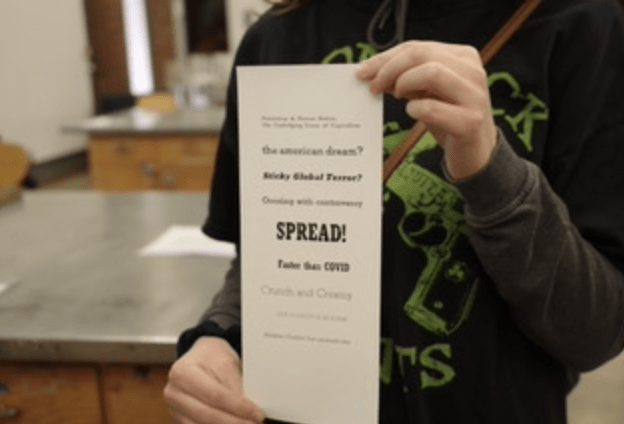Letterpress Print Night
I sort of knew what to expect when I showed up at MSU’s printmaking studio last week for Letterpress Print Night. I knew that I would be setting (and, let’s be honest, very likely spilling or otherwise messing up) type. I knew that at some point ink would have to become involved. And I knew that if all went well I’d walk away two hours later with a handmade print of some kind.

Beyond that, I did not know the level of creative energy that would be asked of me, the way that a week later my brain would still be storming with lines fitted to the theme of Synthetic Chaos. I did not know the importance of checking my type case to make sure that I drew an s from the s compartment and not one of the st ligatures mixed in. I did not know that I would be quizzed on the history of the English alphabet and spend much of the rest of the day chagrined at my failure on that quiz. I did not know that the print I would leave with would be what is called a specimen page. Did I even know what a specimen page is? I did not. But quoting from the handout I got at the workshop I can tell you that it is “a way to showcase a typeface and all of its character for both artistic and informational purposes.” In the case of our workshop, the specimen page we made featured six fonts and mysterious text of our own creation that mentioned lasers, refrigerators, Surrealism, and improvisation and for some reason was written partly in Latin.
One shows up to a class like this expecting to learn both what they are expecting to learn and what they don’t know to expect. The real question is why they show up in the first place, why in the age of InDesign there’d be any reason to. The conversation here could begin and end with the word fun. If you’re like me and you think this sort of thing is cool, you don’t need to be convinced; and if you don’t, you’re probably not going to be.
But I asked Ashely Fuchs anyway. She’s the assistant professor in graphic design at Montana State University’s School of Art which is offering these public workshops in letterpress printing.

“In a world where InDesign exists, people are starving to know more and to understand, through personal experience, concepts about design terminology and origin,” she told me. “Letterpress does just this. Most of the terminology used in InDesign like leading (space between lines of text) and even document units and increments like pica comes from the historic craft of letterpress design.”
Fuchs became interested in letterpress while studying with Ellen Knudson in graduate school at the University of Florida. “I had no idea what she was doing,” Fuchs said, “but I knew I wanted to do it that well one day.”
It was only after being hired at MSU that Fuchs realized the letterpress opportunities available to her and her students. MSU has the largest collection of metal type in all of Montana—over 400 cases.
Now with the public workshops, Fuchs wants to share the magic of letterpress more broadly. “I believe university relationships with the communities around them need to be more symbiotic and inclusive, and these workshops are a way for me to foster new connections and stronger shared experiences across the community.”
“You know when you see someone else’s pure wonder and joy and find yourself also smiling in that shared experience,” Fuchs said to me. “I’m lucky enough to experience this every time someone pulls a print for the first time, and that feeling is worth finding over and over again.”
I witnessed this wonderous response myself as I watched the members of my group admiring their specimen sheets as they came off the press. I felt it myself when it was my turn to print. It seems so simple, printing ink on paper—almost archaic—but there is something profound about it. It’s the tangible elegance of the paper along with the firsthand knowledge of some of the labor that went into it. How often do we hold in our hands' the things we’ve made? I felt like my son after a day of kindergarten as I rushed home to show him what I had spent my afternoon making.
The specimen sheets that are being produced in these workshops will be collected in a specimen book that will feature one line of every typeface in the studio. “This book,” Fuchs said, “fingers crossed, will be completed sometime in spring and will help students in making decisions on typefaces for projects and also will be available to the public. The pride and community print endeavors that went into collaborating on and printing the book I believe will be a big draw for a variety of people to want to purchase the book. And, yes, the book will be letterpress printed.”
There are two workshops remaining: November 16 at 5:00; and November 19 at noon—both meeting in the printmaking studio in Haynes Hall on the MSU campus. For more information and to register, visit https://www.gdgmsu.com/. The workshop costs $10 or is free to MSU students, faculty, and staff.
